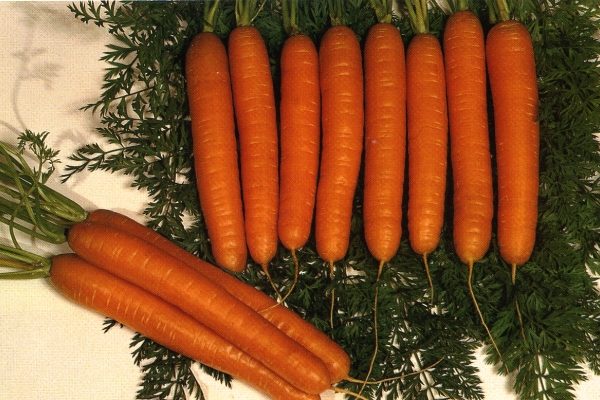The name of the carrot Queen of autumn justifies due to its leadership among the late varieties of carrots, which gardeners appreciate for their high yield, good taste, appearance and long storage period.
Table of contents
Description of the variety and its characteristics
Carrot variety The Queen of Autumn belongs to a group of late-ripening crops. Harvesting begins in mid-October..
Plant with a sprawling leaf rosette with medium leaves of a light green color.
The fruits have the correct elongated shape and length up to 30 cm. The weight of an individual vegetable ranges from 160 to 200 g.
The flesh has a traditional orange tinge and characterized by density, juiciness and sweetness.
The level of sugar contained in carrots varies from 6 to 11%, and the rate of carotene per 100 g of product varies from 10 to 17 g.
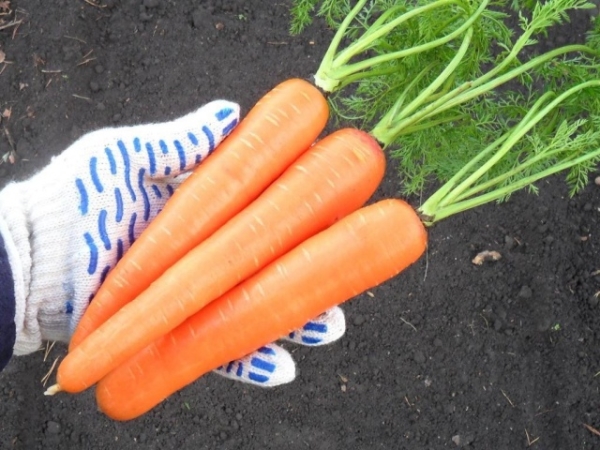
Advantages and disadvantages of the Queen of Autumn
When describing a variety its benefits should be indicated, thanks to which the plant deserves its place in the garden:
- abundant yield, which, under favorable growing conditions, is 9 kg / m2;
- intensive germination of planting seeds and ripening of fruits;
- the attractiveness of the appearance of vegetables and the superiority of taste;
- resistance to cracking while ensuring uniform proper watering;
- good immunity to various diseases of fungal and infectious origin;
- long-term preservation without loss of taste, subject to competent storage;
- a universal product, it is consumed fresh, stewed, juices, mashed potatoes and used for preparations for the winter.
In addition to the positive characteristics there are some drawbackswhich include:
- the formation of root crops of different sizes;
- difficulty in extracting long fruits from dense soil;
- insufficiently saturated coloring of vegetables.

The main secrets of growing carrots
To obtain the maximum yield of vitamin roots of the Queen of Autumn, you must adhere to certain rules of planting and care, while taking into account all the features of the variety.
Preparing the soil for planting
It should advance the preparation of the soil in order to sow the seeds of carrots in the ground was carried out successfully.
Carrots prefer a light, permeable, fertile soil. Heavy soil forms a crust that impedes the process of germination and may cause deformation of root crops.
Land on the selected garden plot need dig in late autumn, fertilizing it with nutrients. In the spring, repeat the procedure to create optimal conditions for placing the seeds.
A few weeks before landing equip soil with ash and humus. There is no need to add fresh manure to the ground, as the crop does not tolerate its acidity.
Also, it is not possible to fertilize with nitrogen-based products; this can cause fast accumulation of a huge amount of nitrates by root crops.

Seed preparation technology
Of particular importance in the agricultural technology of carrots are the seeds of high quality and their preparation for sowing.
Therefore, you want to choose a quality planting material and soak them in warm water for 24 hours for quick germinationby changing it after every three hours.
Then seeds wash well and put in the refrigerator for stratification.
Sowing rules
Sowing seeds should be carried out in late May or early June. in temperate climates.In southern latitudes, landing is recommended in the middle or end of June, where October is not threatened with frost.
Landing is to conduct the following operations:
- Form grooves with a depth of no more than 1-2 cm and water the soil well. The distance between the rows should be at least 15 cm for easy care of the culture.
- Sow planting material to a depth of 0.5-1.0 cm, sprinkle with earth and slightly compacted.
When performing all cultivation techniques, the crop ripens in 117-130 days after carrying out the sowing of seeds.
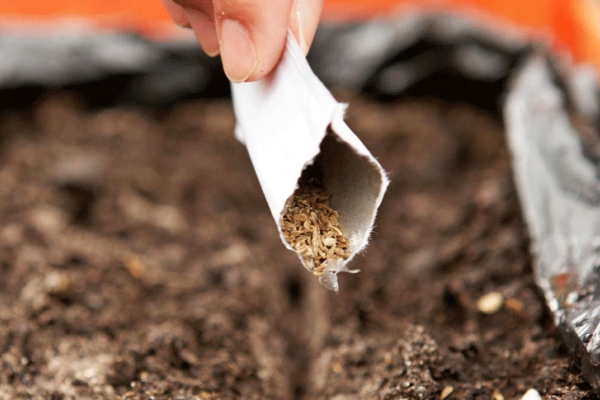
A set of measures for the care of vegetables
Careful care will allow you to achieve stable yields. To do this, you must perform the following activities:
- regularly remove weeds and loosen the beds to saturate the soil with moisture and prevent crust formation;
- moderately watered at all stages of plant development, which will allow vegetables to form smooth, juicy and sweet;
- thin out with the utmost care as the tops grow, so as not to damage the root system of the remaining plants;
- feed carrots with fertilizerby applying organics and minerals.
Diseases and their prevention
Despite the fact that the variety has excellent resistance to diseases, one should not exclude the likelihood of pest infestation and mass reproduction, but take all necessary measures to protect the plant in a timely manner.
At the time of growth and after harvest, the culture is most often exposed to harmful microorganisms. The most dangerous are considered infectious and fungal diseases that cause rotting and fruit damage.
The carrot fly and its larvae are the treacherous pests of the root crop.. The appearance of a bronze shade on the leaves indicates their appearance. Damaged carrots become bitter, loose and unfit for consumption.
To prevent the occurrence of this pest, you need to constantly loosen the beds, prevent stagnation of water and shade. And in case of detection of a problem to destroy by spraying with insecticides.
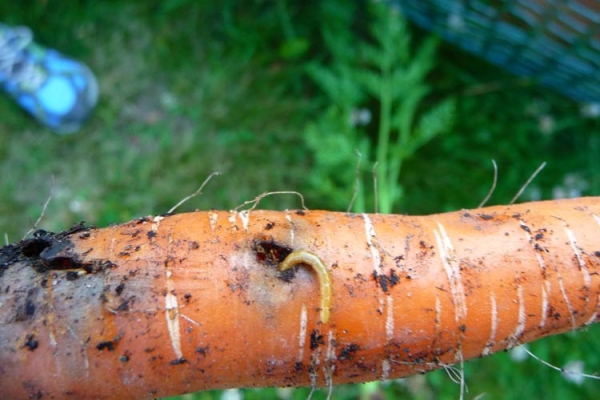
Harvesting and storage of the harvest
Timely cleaning will positively affect the shelf life of the root. Therefore for this purpose it is necessary:
- correctly determine the period of harvestbecause the carrots that are unripe are prone to rotting, and the overripe is affected by the parasites;
- few days before harvesting reduce the number of irrigationsthat will help preserve the sweetness and juiciness of carrots;
- choose a fine sunny day and harvesting with your hands or podkapat with a shovel, carefully removing the clod of earth together with the roots, and then pulling them one by one from the tops;
- do not clean the vegetables from the ground and do not wash them, as it can accelerate the development of diseases;
- gently cut the tops with a knife below the growth point of 0.5 cm, because the greens not only reduces the weight of carrots by absorbing its juices, but also greatly impair its nutritional value;
- after trimming the roots dry and put in a dark place at a temperature of 10-14̊ C for 15 days, this will allow the fruits to heal injuries, and sick specimens to reveal defects;
- after the specified time has elapsed, sort the harvested crops, removing the damaged ones,sick and soft specimens;
- After all the processes are completed, you can proceed to the laying of the crop for storage.
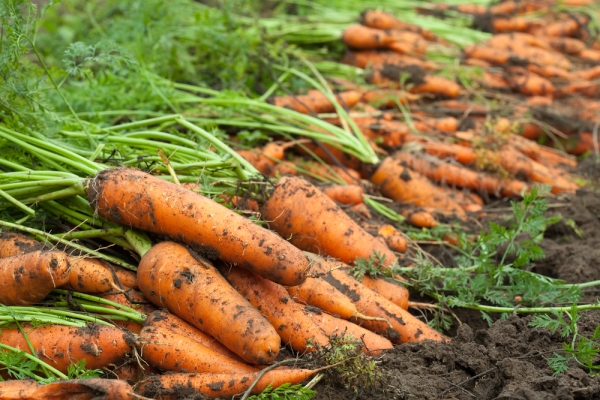
The product must be provided with certain storage conditions. The ideal storage is considered to be the cellar or basement.in which follows:
- maintain a constant temperature in the range of 0 to 5 ° C;
- organize optimal humidity 90-95%.
Such conditions will help preserve the roots until the next harvest without loss of quality.
Since fresh and juicy vegetables is not only a tasty treat, but also a natural source of nutrients, vitamins and minerals.
